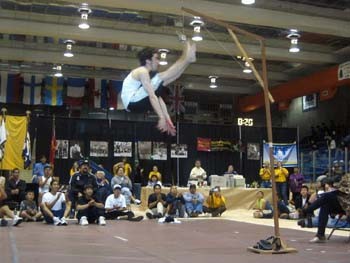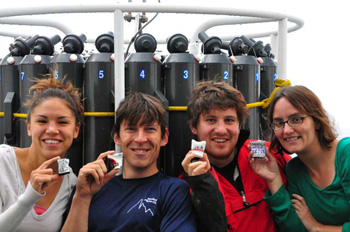September 14th
The high kicks are thought of to be a signal of a successful hunt. When a hunter was in sight of a village or encampment when returning from a successful hunt, he would begin jumping and kicking. The people in the village would then know to head out onto the ice to help bring in the catch. For the Canadian style of the one-foot high kick, the athlete must jump off of both feet, kick, and land with the same foot that is used for the kick. The record for this event is 9’8” for the men and 7’7” for the women. Another style of the high kick is the two-foot high kick. In this event, the athlete has to jump, kick and land with both of his feet together throughout the entire maneuver. The record for this event is 8’8” for the men and 6’6” for the women. Another game testing balance is the one-hand reach. The athlete has to balance his body on one hand, reach up to touch the ball with the other, and return without touching his legs or feet on the floor. The record is 5’9” for the men and 5’2” for the women. Another game is the Alaskan high kick, where the athlete must start in a sitting position, hold on to one foot with the opposite hand, swing their body up to kick the ball, and land on their kicking foot while maintaining balance after the attempt. The record is 8’ for the men and 6’3” for the women. The ear pull tests the ability to endure pain due to frostbite. Winter temperatures in the Arctic reach as cold as -80F, and when you leave your ears uncovered in these conditions they can freeze. In the ear-pull, the contestants must place a string around one ear and pull. The winner is the one who can withstand the pain the longest. It usually takes some pretty tough ears to win a championship. Many different types of entertainment games exist in the north. One of many popular gambling games in Canada is known as ‘hand games’ or ‘stick gambling.’ In this game, two teams face each other while sitting cross-legged or on their knees. Singers usually surround the teams on the floor, where throughout the night they will sing and drum for hours at a time until the match is over. While the drummers sing gambling songs, one team commences to switch stones or small objects between each of their ‘teammates’ and the other team has to guess which hands the small objects are in. The score is kept using sticks and the game continues for hours, ending with either bragging rights or a fairly large cash prize. Numerous laughter and humor games are played, too many to count. One game, called ‘Muk,’ calls on an individual to stand up in the middle of the room or group in attempt to make one person in the room smile or laugh. The first person to smile or laugh is the next person to stand in the middle. A long song starts off each round, sounding something like “uptonnikta, booqitannikta, uptonnikta, booqitannikta, nipinisuk MUK!” After everyone yells ‘Muk’ then the game begins. The Inuit games are just one way to help survive the long and cold Arctic winters. Every culture has its fun and parties. Smile and laugh once in awhile – you’ll live longer.
After working in the Chukchi Sea and exploring the properties of the “Western Arctic Boundary Current” for several days, the ship made its way into the Beaufort Sea. The Healy’s CTD was probing into the deepest waters yet. At 3:20pm the CTD watchstanding crew launched its hundredth cast, but this time with a bag of Styrofoam cups attached to the Rosette. Zach Brown, a second-year PhD chemistry student at Stanford University, suggested that we (those who wanted to partake in the experiment) give him Styrofoam cups with our own original designs drawn on them. When subjected to intense isostatic pressure, a Styrofoam cup will shrink to almost the size of a thimble because its internal gases will be forced out. The crew members drew designs on their cups, added them to the bag, and soon were rewarded with their miniature cups! Games are important to keep long journeys upbeat and positive.
Last updated: September 29, 2010 | |||||||||||||||||
Copyright ©2007 Woods Hole Oceanographic Institution, All Rights Reserved, Privacy Policy. | |||||||||||||||||


